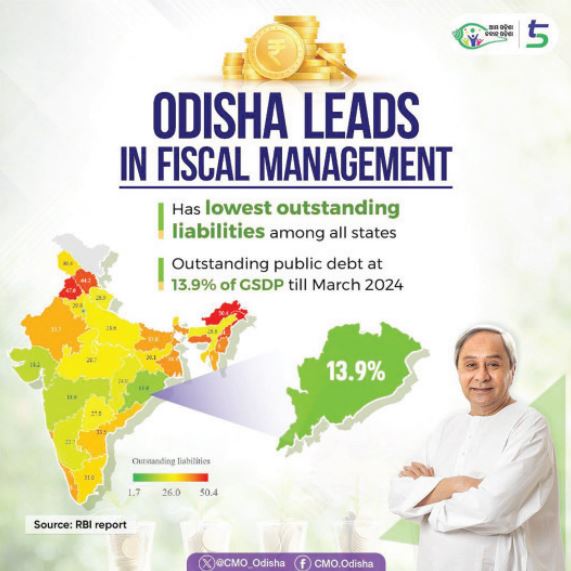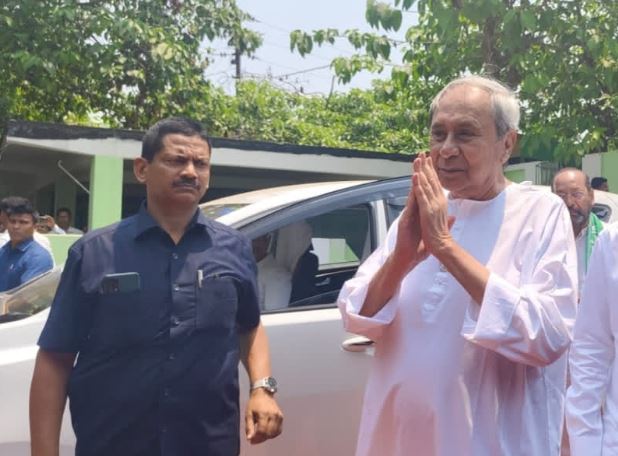Bhubaneswar: The transformative efforts of the Government of Odisha under the revolutionary 5T Initiatives have made it the leader in Fiscal Management in the country. The latest report by the Reserve Bank of India reinforces Odisha’s fiscal discipline and proves how carefully the State has managed to make significant improvements in its finances and became the numero uno in the country. The latest State Finances Report 2023-24 of the Reserve Bank of India shows that Odisha has the lowest outstanding liabilities as percentage of the Gross Domestic Product in the country. According to the report, Odisha has an outstanding liability of just 13.9 percent of the GSDP as at end of March 2024. Odisha’s outstanding liabilities as percentage of the Gross State Domestic Product stood at 13.9 percent. It is the lowest liability percentage for any state of India. Another significant finding of the Report is that the State’s Own Non-Tax Revenue, (SONTR) as a proportion of total revenue, stood at 27.8 percent – which is highest in the country. The debt to GDP ratio of Odisha has reduced significantly post Covid period due to the prudent efforts of the state government. In terms of SONTR, as proportion to total revenue has left behind all the states. Bigger states such as Tamil Nadu, Gujarat, Karnataka, Maharashtra, West Bengal, Uttar Pradesh, Andhra Pradesh have registered SONTR below 10 percent. As per the Report, Odisha’s total tax revenue has seen a rise from 46.8 percent during the preCovid period in 2015-16 to 53.5 percent during the post-Covid period. Also, it says the State’s expenditure has risen from 3.1 percent in 2006-07 to 6.9 per cent of the aggregate spending in 2023-24 on medical and public health and Rs 4,630 crore to Rs 36,591 crore on wages and salaries. As part of its efforts, Odisha has been continuously increasing pending on research and development and it has gone up from 125 percent in 2020-21 to 500 per cent in 2023-24 in education sector, 25.7 percent to 105.8 percent in medical, health, family welfare and sanitation, 24.6 percent to 199.2 percent in agricultural research, 2.2 percent to 22.7 percent in industrial research and 15.6 percent to 17.9 percent in environmental research. In the last three years, the Development sector expenditure of Odisha has also recorded significant increase. The Development Sector expenditure has risen from Rs 98,101.4 crore in 2021 to Rs 1,60,407.5 crore in the 2023-24. While all the states are resorting to heavy market borrowings with higher interest rates, despite their huge debt burden, Odisha has been consistently keeping itself away from market borrowings. In the last three years Odisha made zero market borrowings and on the other hand it has made repayments of borrowings of more than Rs 15000 crore in the last three years. According to the Reserve Bank of India, Odisha’s success has been possible due to its fiscal management policies. Also, creation of a separate Directorate of Minor Minerals under Revenue & Disaster Management Department for scientific and sustainable management of minor minerals, use of electronic auction and new premium policy to augment mining revenue, suitable amendments of Odisha Irrigation Rules, 2016 to enhance Industrial Water Rate (License and special water rate) automatically by 10 per cent annually have helped the state. Government of Odisha has undertaken a number of fiscal reform measures in last two decades, which aimed at expenditure rationalization and revenue generation. It has succeeded in bringing about a turnaround in the State’s finances. It is important that all committed expenditures and developmental expenditures are met from the borrowing space, without resorting to off-budget or any non-transparent means of financing for any expenditures. The State has been able to reduce the debt stock from 50.7% of GSDP in 2002-03 to below the prudential level of 25% as recommended by the 13th Finance Commission and prescribed in Odisha Fiscal Responsibility and Budget Management (OFRBM) Act, 2005. The ratio of interest payment to revenue receipt (IP/RR) ratio, which should be within the prudential level of 15%, has also been achieved and consistently maintained. Strong fiscal performance of the state by fulfilling these criteria gives the state an additional fiscal space over the prescribed fiscal deficit 3% of GSDP. Odisha’s success has been possible due to its transformative steps taken under the 5T Initiatives. The State has been perusing various strategies for management of its finances and budgetary reforms. In terms of both revenue generation and expenditure, prudent planning and strategy have helped Odisha to lead the country. Under the leadership of Chief Minister Naveen Patnaik, Odisha has transformed itself from being one of the most backward states to the current leadership position. In the last 23 years, the Naveen led government, that boasts of its actions rather than publicity, has transformed all indicators of human development. Particularly during the last decade, Odisha’s thrust on technology base transformation has helped it to precisely act on the issues and resolve them. Odisha’s turnaround story through transparency and honesty has helped it to outsmart other big states financially. While the big states are reporting large debt increase, and their fiscal condition getting worse day by day, Odisha has crafted a turnaround story that has made all surprised. It is possible only due to the uninterrupted good governance of the last 23 years led by CM Naveen Patnaik, a forward looking and progressive bureaucratic system, transparency, industry friendly policies and implementation of digital initiatives, as they have all helped it to come to this stage. The role of Kartik Pandian, Chairman, 5T Transformational Initiatives and Nabin Odisha, is also significant in Odisha’s journey towards fiscal prudence. The thrust on adoption of Technology, Transparency, Teamwork, Time, and Transformation being the core principles of Odisha Government for the last few years, have helped it to bring development to the common man.
Exclusive
Breaking News
 India – New Zealand joint trade committee acknowledges in both economies
India – New Zealand joint trade committee acknowledges in both economies
 PM Gears Up for Bengal Blitz with Public Meetings in Key Constituencies On May 3
PM Gears Up for Bengal Blitz with Public Meetings in Key Constituencies On May 3
 Docs Warn Gym Goers as Sudden Heart Attacks Return, Killing at least 4
Docs Warn Gym Goers as Sudden Heart Attacks Return, Killing at least 4
 CM Files Nomination for Hinjili Assembly Seat
CM Files Nomination for Hinjili Assembly Seat
 Liquors Policy Scam: ED has no material necessitating my arrest, Kejriwal tells SC
Liquors Policy Scam: ED has no material necessitating my arrest, Kejriwal tells SC






More Stories
India – New Zealand joint trade committee acknowledges in both economies
PM Gears Up for Bengal Blitz with Public Meetings in Key Constituencies On May 3
Docs Warn Gym Goers as Sudden Heart Attacks Return, Killing at least 4